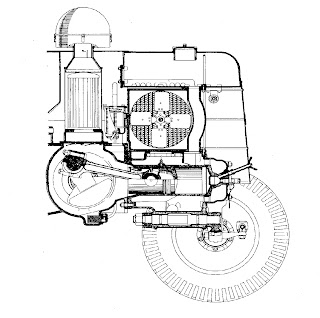TWO-STROKE TRACTOR ENGINES
 Two-stroke tractor engines are invariably of the compression-ignition type. Some small cultivators have two-stroke spark-ignition engines also.
Two-stroke tractor engines are invariably of the compression-ignition type. Some small cultivators have two-stroke spark-ignition engines also.Crankcase-compression scavenging is employed in the exceptionally simple single-cylinder 'valveless' engines of which considerable numbers have been built. An example is shown in Figure 5, and the sequence of events in an engine of this kind is shown in the lower diagram in Figure 6. On the compression stroke of the piston, air is inducted into the crankcase through a non-return valve. On the power stroke the air in the crankcase is compressed to a pressure slightly (perhaps 2 lb./sq.in.) over atmospheric. Near the end of this stroke the piston uncovers an exhaust port in one side of the cylinder wall, and then a 'transfer port' in the other, communicating with the crankcase; the top of the piston (the 'piston crown') is so shaped that the air thus entering the cylinder takes a path promoting scavenging and sweeps residual burnt gases out through the exhaust port. As the piston begins the next stroke it covers both ports and a new cycle follows.

i personally like the post.........
ReplyDeletehope u post more about this.........
innovative man.........
ReplyDelete